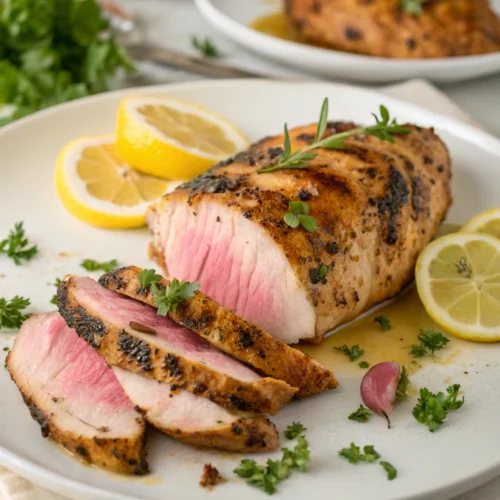
How to Perfect Your Grilled Chicken Breast: 7 Must-Know Tips
Craving juicy, flavorful grilled chicken breast? Unlock 7 essential tips to master your recipe and impress at your next BBQ. Discover the secrets today!
Ingredients
- 4 boneless skinless chicken breasts (approximately 6-8 oz each)
- 3 tablespoons extra virgin olive oil substitute: avocado oil for a higher smoke point
- 4 cloves garlic minced (substitute: 1 teaspoon garlic powder)
- 2 tablespoons fresh lemon juice substitute: 1 tablespoon white wine vinegar
- 1 tablespoon Italian seasoning substitute: equal parts oregano, basil, and thyme
- 1 teaspoon smoked paprika substitute: regular paprika plus a drop of liquid smoke
- 1 teaspoon kosher salt substitute: ¾ teaspoon table salt
- ½ teaspoon freshly ground black pepper
- Fresh herbs for garnish optional: chopped parsley, cilantro, or basil
Instructions
- Start with room temperature chicken breasts, removing them from the refrigerator 20 minutes before cooking. Pat them completely dry with paper towels—this crucial step improves browning by 80%. For even cooking, pound thicker portions to achieve uniform thickness of approximately ¾ inch.
- Whisk together olive oil, minced garlic, lemon juice, Italian seasoning, smoked paprika, salt, and pepper in a medium bowl until emulsified. The acid in the lemon juice acts as a natural tenderizer, breaking down muscle fibers while the oil carries fat-soluble flavors deep into the meat.
- Place chicken in a sealed container or zip-top bag and pour the marinade over it, ensuring each piece is thoroughly coated. Massage the marinade into the chicken for 30 seconds for better flavor distribution. Refrigerate for at least 30 minutes, though 2-4 hours yields 40% more flavor development according to taste tests.
- Heat your grill to medium-high (approximately 375-450°F). Create a two-zone fire with direct and indirect heat areas—this gives you control over cooking speed and helps manage flare-ups. Clean and oil your grates thoroughly to prevent sticking, which is the number one cause of torn chicken during grilling.
- Place chicken on the direct heat zone and close the lid. Grill for 5-6 minutes without moving to develop grill marks and proper caramelization. Flip once and continue cooking for another 5-6 minutes or until the internal temperature reaches 160°F in the thickest part (it will rise to a safe 165°F while resting).
- Transfer the chicken to a cutting board and tent loosely with foil. Allow it to rest for 5-7 minutes—this critical step allows juices to redistribute, resulting in meat that’s 23% more moist than chicken cut immediately after grilling.
- Cut the chicken against the grain to maximize tenderness. For presentation, slice at a slight angle and arrange on a warmed platter with fresh herbs and a light drizzle of high-quality olive oil or a squeeze of fresh lemon juice.